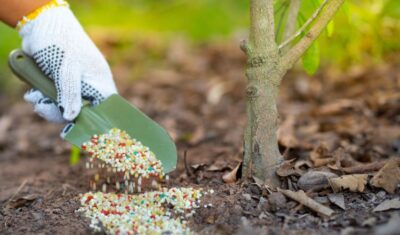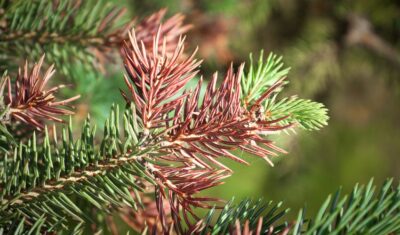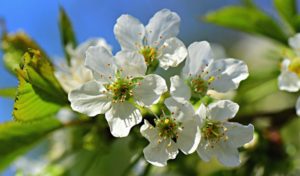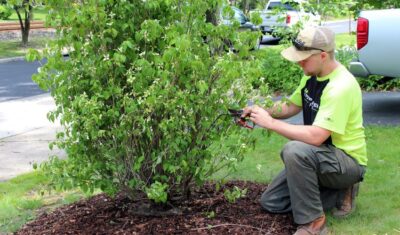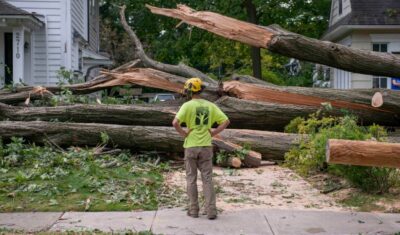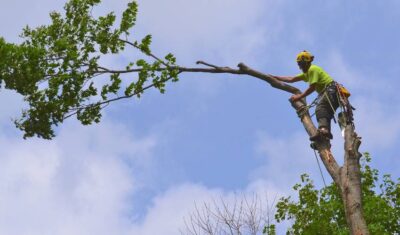Have you ever admired a tree, marveling at its strength and resilience? They seem invincible. Yet, just like a superhero with a hidden weakness, trees have an Achilles heel – herbicides. If not used correctly, herbicides harm trees.
This article will get you up to speed on herbicides and trees by exploring the following:
- What Herbicides Are
- How Herbicides Can Harm Trees
- Signs Your Trees Are Being Harmed by Herbicides
- Keeping Your Trees Safe from Herbicides
- Tree-Safe Alternatives to Herbicides
- Treating Herbicide-Damaged Trees
So, read on and learn how herbicides can harm your trees and what you can do to prevent this potential killer from striking.
What Are Herbicides?
You might be wondering, ‘What are herbicides?’ Well, they’re chemicals used to control and eliminate unwanted plants or weeds, but they can potentially harm your trees if not used correctly.
Herbicides are powerful tools for managing the growth of unwanted plants. They’re often used in fields, gardens, and landscapes to control the spread of invasive or harmful weeds.
Herbicides work by interfering with the growth of plants. Some herbicides are selective, targeting specific types of plants, while others are non-selective, killing any plant they come into contact with. This is why it’s crucial to use them with caution.
While herbicides are designed to control weeds, they can also affect non-target plants, including your trees. If a herbicide drifts onto a tree or is absorbed through its roots, it can cause symptoms ranging from leaf curling to complete death of the tree. So, it’s vital to use herbicides responsibly and follow all label instructions carefully.
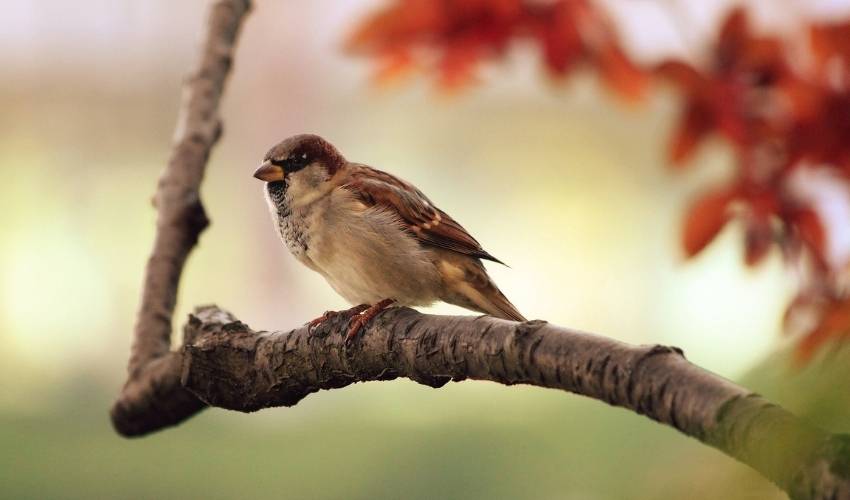
When herbicides harm trees, wildlife can lose crucial habitat.
How Can Herbicides Harm Trees?
It’s important to know that certain chemicals used for weed control can indeed damage or even kill your trees. Herbicides, if misused, can cause significant harm. The risk of herbicide damage is especially high if these chemicals come into contact with the tree’s foliage or are absorbed by the roots from the surrounding soil.
Imagine watching the trees you’ve lovingly nurtured start to wither and die from herbicide damage, their leaves curling and turning strange colors.
Picture the heartbreak of seeing once lush, green foliage reduced to a brown, desolate sight.
Visualize having to remove a once majestic tree from your yard, reducing your home’s curb appeal and potentially impacting its value.
Think about the potential harm to local wildlife that depend on your trees for food and shelter.
Now, put yourself in the shoes of your trees. They’re helpless against the harmful effects of the chemicals you might be considering for weed control. This is what makes proper herbicide use and application a crucial consideration when trying to control unwanted plants and weeds.
What are the Signs That My Trees Are Being Harmed by Herbicides?
Look out for signs that your green friends could be suffering from the unintended effects of weedkillers. The signs of damage from herbicides vary depending on the type and concentration of the herbicide, the plant exposed, its stage of growth, and environmental factors.
Some common symptoms include:
- Deformed foliage such as leaf cupping, curling, twisting, puckering, or strapping
- Twisted, curled, or stunted stem and branch growth
Additionally, clusters of stunted shoots or leaves can be a clear indicator of herbicide damage. Pay attention to discoloration in the foliage, like yellow, white, reddish, purplish, or abnormally light or dark green hues. Leaf scorch, where leaf edges turn tan to brown, flecking, or complete browning and death of leaves are other signs you should watch out for.
If your trees are dropping leaves or needles prematurely, it could be a result of defoliation due to herbicides. In severe cases, you might observe branch dieback or even death of the entire tree.
It’s important to remember that some of these signs – brown leaves in the fall or leaf and needle loss – are a natural part of a tree’s season cycle. However, proper identification of these signs can help save your trees from further damage.
How Can I Keep My Trees Safe When Using Herbicides?
Taking precautions when using weedkillers can ensure the safety of your green friends. Herbicides harm trees when not used correctly or when applied indiscriminately. Here are some steps you can consider to keep your trees safe:
- Be mindful of the application
- Read and follow all herbicide label directions. Look out for restrictions that limit drift, vaporization, and runoff.
- Most damage occurs in spring, so try to shift weed control to fall when many weeds are more manageable and the risk to trees is lower.
Also, it’s important to consider the tree’s location:
- Be aware of your surroundings. Parks, gardens, nurseries, and natural areas nearby can have sensitive vegetation.
- Remember, tree root systems often extend well beyond the canopy edge.
- Consider other methods of weed control like cultivation, mulching, and mowing weedy tree sprouts.
The key is to be cautious about where and how you apply herbicides. Don’t just spray weedkillers haphazardly. Understand the plant material you’re targeting to ensure you’re not applying herbicides directly onto the tree.
By taking these steps, you can effectively use herbicides without causing harm to your trees.
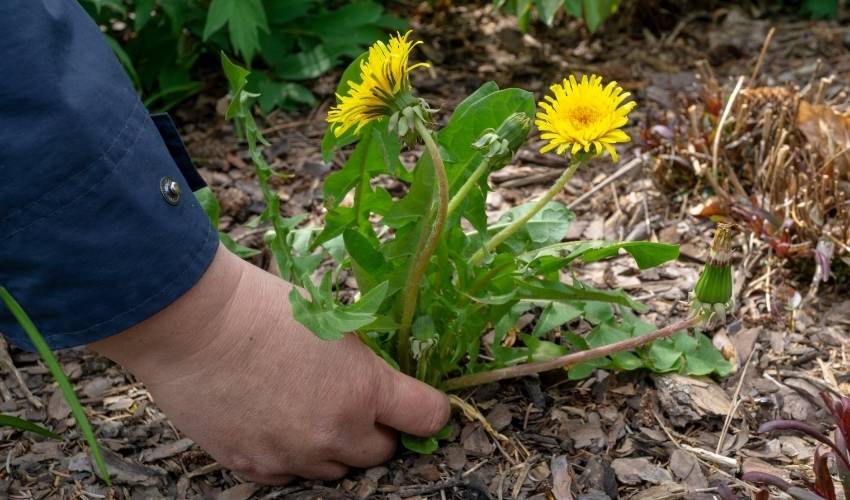
The manual removal of weeds is a labor-intensive, but safe alternative to using herbicides that could harm your trees.
What Are Some Tree-Safe Alternatives to Herbicides?
If you’re seeking alternatives to weedkillers that won’t jeopardize your trees, there are several options to consider.
Manual Weed Control
One of the most effective methods is manual weed control. This involves physically pulling out the weeds by hand or using a hoe. It may take a bit more effort, but it’s an excellent way to ensure you’re not accidentally hurting your trees.
Mulching
Another approach is mulching, which can suppress weed growth and improve soil health. Mulch can act as a barrier, preventing weed seeds from reaching the soil and germinating. You can use organic mulch like wood chips, straw, or compost, which will additionally enrich the soil as it breaks down.
Selective Herbicides
If you still have stubborn weeds, you might consider using a selective herbicide. These are designed to target specific types of plants while leaving others unharmed. Make sure to carefully read and follow the label instructions to avoid any accidental damage to your trees.
Strategic Use of Ground Cover Plants
Integrating ground cover plants can crowd out weeds and reduce their growth. These plants can provide a beautiful, low-maintenance alternative to a traditional lawn. Remember, the key is to be proactive and consistent in your weed control efforts.
Some common Northeast Ohio ground cover plants include ivy, Japanese spurge, and vinca minor.
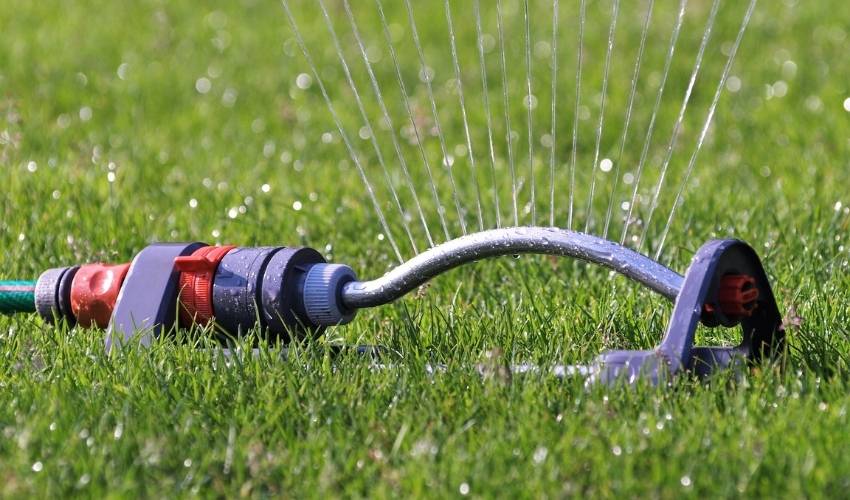
If you suspect herbicides are hurting your trees, stop using the herbicide immediately, and provide plenty of water to help your tree flush out the poison.
How Do You Treat Herbicide Damage to Trees?
Once you’ve identified that your tree has suffered herbicide damage, there are several steps you can take to help it recover.
- Stop using the herbicide immediately. This is critical to prevent further harm to the tree.
- Provide the tree with plenty of water. This can help wash away the herbicide from the leaves and root system. If the weather is dry, consider installing a drip irrigation system to ensure the tree gets a consistent water supply. However, don’t overwater, as this can cause the roots to rot and could potentially kill the tree.
- Apply high-quality tree fertilizer. This can help boost the tree’s ability to recover. Select a fertilizer that is specifically designed for trees. Apply according to the package instructions for the size and species of your tree.
Remember, recovery from herbicide damage can take time. Be patient and continue to provide your tree with the care it needs. If the tree continues to decline, it might be time to call in a professional arborist for further evaluation and treatment.
Can Trees Recover from Herbicide Damage?
You may be wondering if your tree can bounce back after herbicide damage. The good news is trees are incredibly resilient and often can recover from light and occasional herbicide damage. However, the severity of the damage and the tree’s health before exposure greatly influences its ability to recover.
Factors such as the type and concentration of the herbicide, the tree’s stage of growth when exposed, and environmental conditions will all play a role in the tree’s recovery. If the damage is not too severe, the tree may simply shed its damaged foliage and produce new, healthy leaves.
Over time, it may even be able to repair or compartmentalize damaged tissue within its trunk or branches. However, repeated exposure to herbicides over several growing seasons can significantly weaken a tree, making it more susceptible to other stresses, such as drought, pests, or disease. This can eventually lead to the tree’s decline and death.
So, while your tree might recover from a single instance of herbicide damage, it’s crucial to prevent repeated exposures. Instead, consider alternative weed control methods, like mulching, mowing, or hand-pulling weeds.
Don’t lose hope – many trees can recover from herbicide damage with the right care and attention.
Frequently Asked Questions
What types of trees are most susceptible to herbicide damage?
Yes, certain trees are more susceptible to herbicide damage. Particularly sensitive ones include oaks, redbud, honeylocust, Kentucky coffeetree, elms, and maples. They can be severely affected, especially during spring when new foliage is emerging.
How long does it take for herbicide damage to show on trees?
Caught in a web of worry about herbicides? The timeline for damage varies. However, many signs, like leaf discoloration or curling, can be noticeable within a few days to a week of exposure.
Are there specific herbicides that are safer for use around trees?
Yes, some herbicides are less harmful to trees. Glyphosate, for instance, is broken down by microbes and generally inactive in soils. However, always read and follow label directions to ensure safe use around your trees.
What can I do if my tree has been accidentally exposed to herbicides?
If your tree’s been exposed to herbicides, promptly water the area to dilute the chemical. Consult with a local extension office or the Nebraska Forest Service for advice. Avoid future spraying near your trees.
Can prolonged exposure to herbicides affect the soil quality around my trees?
Absolutely, like a thief in the night, herbicides can stealthily rob your soil of its quality over time. Prolonged exposure can alter soil composition, making it less hospitable for your tree’s root system.
How Herbicides Harm Trees – Final Thoughts
So, can herbicides harm your trees? Absolutely, if not used wisely. Remember, the key is thoughtful application and vigilance. Always follow the label instructions and consider tree-safe alternatives.
If you notice signs of damage, act promptly. With proper care, your trees can recover. But wouldn’t it be better to prevent herbicide damage in the first place?
Do Your Trees Need Some TLC?
Call Independent Tree today at 440-564-1374. We offer a host of tree health services, including fertilization and soil improvement programs to make sure your Northeast Ohio trees get the things they need and are protected from the effects of harmful herbicides.
Proudly serving eastern Cuyahoga, Geauga, Portage, and Lake Counties!
Want to know more about herbicides that might harm your trees?
Contact Independent Tree to schedule an inspection or ask us about our tree services. We can help you identify the right herbicides for the safety of your trees in your property.Recent Articles
Topics
About The Author

STAY IN THE LOOP
WITH OUR
LATEST UPDATES
"*" indicates required fields

